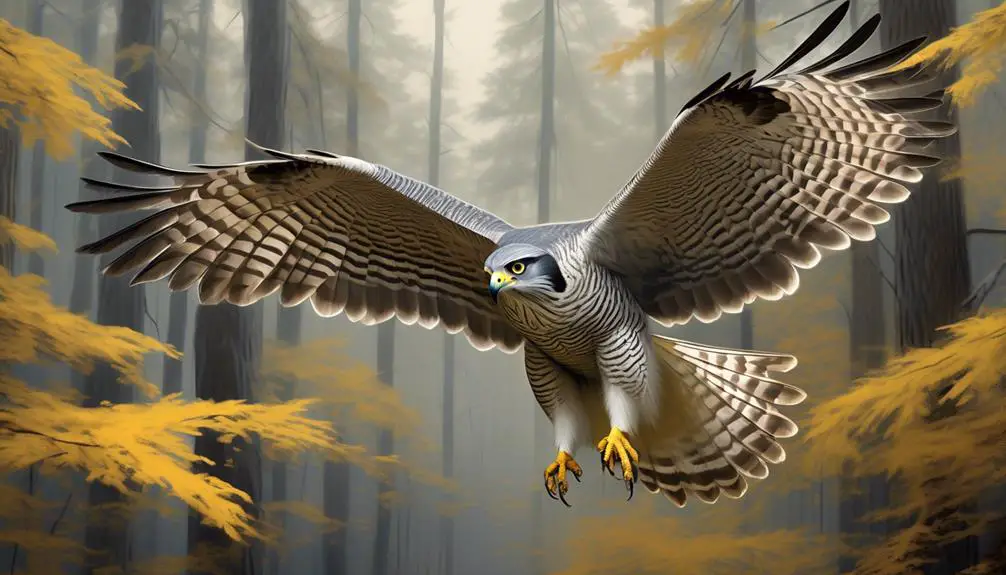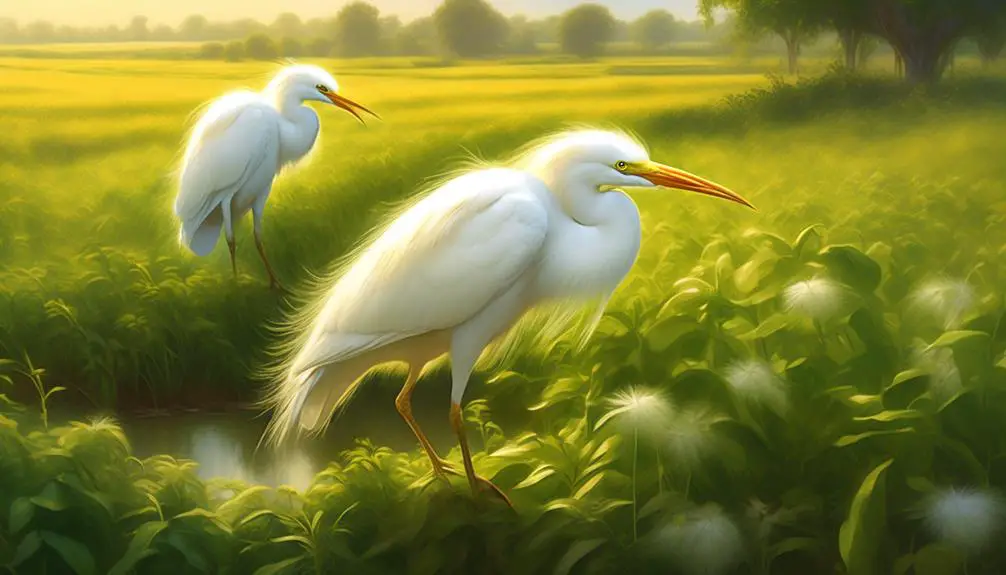Imagine standing in a vast meadow, surrounded by a kaleidoscope of colors, as if you were peering into a magnificent tapestry woven by nature itself.
Amongst the vibrant hues, you spot a flash of iridescent feathers, captivating your attention and igniting a curiosity deep within.
Ohio, a state often overlooked for its avian wonders, is home to a collection of rare birds that will leave you in awe. From the secretive Burrowing Owls to the regal Northern Goshawks, each species holds its own unique charm and allure.
But that’s just the beginning. As you venture further into the realm of Ohio’s avian treasures, prepare to be enthralled by the striking beauty and extraordinary tales of these elusive creatures.
Burrowing Owls

Burrowing Owls, known by their scientific name Athene cunicularia, are a species of birds that nest in underground burrows created by other animals. These unique birds have adapted to living in burrows, which provides them with protection from predators and the elements. Burrowing Owls are small in size, measuring about 9 to 11 inches in length, with a wingspan of approximately 21 inches. They’ve long legs and short tails, which make them well-suited for life underground. Their feathers are brown with white spots, helping them blend in with their surroundings.
These owls have a distinct call, which is a series of short, low-pitched hoots. They’re primarily active during the day, hunting for small mammals, insects, and reptiles. Their diet consists mainly of rodents such as mice and voles. Burrowing Owls are also known for their unique behavior of standing on their burrow entrances, which gives them a vantage point to watch for potential threats.
In Ohio, Burrowing Owls are a rare sight. They’ve been spotted in a few locations, including Brecksville-Broadview Heights and Cuyahoga Valley National Park. The population of Burrowing Owls is decreasing, making sightings even more uncommon. Conservation efforts are underway to protect their nesting sites and promote their habitat conservation.
Northern Goshawks

Northern Goshawks, scientifically known as Accipiter gentilis, are majestic birds with grey-black plumage and distinctive white stripes. These birds are large, measuring around 20 to 26 inches in length and weighing between 2 and 3.5 pounds. They’ve broad wings and long tails, which aid in their exceptional flying and hunting skills. Northern Goshawks are known for their acute vision, allowing them to spot their targets from great heights. They’ve powerful talons and beaks, which they use to capture and kill their prey, primarily other birds and small mammals.
These birds are found in various habitats, including coniferous forests, mixed woodlands, and mountainous regions. They’re known for their territorial nature and will fiercely defend their nesting sites. The nests are built on sturdy branches, usually high up in trees. Northern Goshawks lay 2 to 4 eggs and both parents take turns incubating them for about a month.
The population of Northern Goshawks is currently stable, and they’re classified as least concern by conservation organizations. However, loss of habitat and disturbance by human activities can pose threats to their populations. It’s important to continue monitoring and protecting these magnificent birds to ensure their long-term survival.
White Ibises

White Ibises, scientifically known as Eudocimus, can be found in Sandy Ridge and Metzger Marsh Wildlife areas in Ohio. These elegant birds are easily recognizable by their striking white feathers, orange legs, and curved beaks. White Ibises have a conservation status of least concern, with a stable population in Ohio. They’re known to forage in groups, which provides them protection against predators. The population of White Ibises has been steadily growing due to the abundance of food sources available to them.
White Ibises are commonly found in wetland habitats, where they can easily access their preferred diet of small aquatic animals, such as fish and crustaceans. They use their long, curved beaks to probe the soft mud or shallow water, searching for prey. Their specialized beaks allow them to efficiently catch and consume their food.
These birds are highly social and often seen in large flocks, especially during the breeding season. They build nests in trees or shrubs near water, using sticks and twigs. Both the male and female ibises take turns incubating the eggs and caring for the young.
Western Tanagers

Continuing our exploration of rare birds in Ohio, let’s now turn our attention to the Western Tanagers. These vibrant birds are uncommon to spot in the chilly and damp Ohio climate, but when they do make an appearance, their tropical-like feathers add a burst of color to the landscape. Western Tanagers are known for their ability to conceal themselves in bushes while feeding on fruits, seeds, and insects. The males of this species are highly vocal during the spring and summer seasons, creating a symphony of calls that can be heard throughout their habitat.
To provide a clearer picture of the Western Tanagers, here is a table summarizing some key information about these fascinating birds:
| Western Tanagers | |
|---|---|
| Scientific Name | Piranga ludoviciana |
| Conservation Status | Least concern (population stable) |
| Habitat | Conceal themselves in bushes while feeding on fruits, seeds, and insects |
| Vocalizations | Male tanagers highly vocal during spring and summer seasons |
As you can see, Western Tanagers are a unique and captivating species that bring a touch of the tropics to Ohio. While they may be rare sightings, their vibrant feathers and melodic calls make them a true delight for bird enthusiasts lucky enough to spot them in the wild.
Pacific Loons

The Pacific Loon, scientifically known as Gavia pacifica, is an uncommon waterfowl species found primarily in the northern Pacific region, with habitat around large water ponds in Ohio.
This relatively large waterfowl exhibits substantial bodies and wings, allowing for impressive diving and flight speeds. The plumage of the Pacific Loon is characterized by a mottled pattern of black and white, providing effective camouflage in its aquatic environment. Its bill is long and pointed, aiding in the capture of fish, its primary food source. With its strong legs and webbed feet, the Pacific Loon is well adapted for swimming and diving. When foraging underwater, it can descend to considerable depths, holding its breath for extended periods. Its flight is swift and direct, propelled by powerful wingbeats.
During the breeding season, the Pacific Loon migrates to its breeding grounds in the Arctic tundra. It forms monogamous pairs and builds nests near water bodies. The population of Pacific Loons is currently increasing, and efforts are being made to protect their habitats and ensure their conservation.
American White Pelicans

Moving on to another fascinating bird species in Ohio, let’s now explore the American White Pelicans, known for their robust bodies and impressive wingspan. These magnificent birds can often be spotted in shallow freshwater lakes and wetlands throughout Ohio. American White Pelicans are characterized by their large size, with adults reaching a length of 50-70 inches and weighing between 11-20 pounds. Their wingspan can span up to 9 feet, making them one of the largest birds in North America.
One of the most notable features of American White Pelicans is their unique throat pouch, which they use for catching and storing fish. This pouch can hold up to 3 gallons of water, allowing them to scoop up large quantities of fish in a single dive. Their bills are long and straight, with a slightly curved tip, enabling them to effectively capture their prey.
These pelicans are highly social birds and are often seen congregating in large flocks. They’ve a graceful flight pattern, soaring effortlessly above the water, and are known for their synchronized group fishing behaviors. American White Pelicans primarily feed on fish, but they’ll also consume amphibians and crustaceans.
In terms of conservation status, American White Pelicans are currently classified as ‘least concern’ with their population numbers increasing. However, they still face threats such as habitat loss and disturbance at nesting sites. Efforts to protect and preserve their habitats are crucial to ensure the continued success of these magnificent birds in Ohio.
Cattle Egrets

As you explore the rare birds of Ohio, one species that stands out is the Cattle Egret (Bubulcus ibis).
These fascinating birds possess unique feathers that undergo color changes, ranging from white during breeding season to a more golden hue during non-breeding periods.
You can often find them in fields and grasslands near livestock, as they take advantage of the insects and small reptiles that are stirred up by grazing animals.
Their habitat and feeding habits make them a truly remarkable addition to Ohio’s avian diversity.
Color-Changing Feathers
Cattle Egrets, with their unique feathers capable of undergoing color changes, are fascinating avian species found in Ohio primarily around Lake Erie. These birds exhibit a remarkable ability to alter the color of their plumage based on various factors such as breeding season, age, and environmental conditions. The table below highlights the color variations observed in Cattle Egrets:
| Feathers | Breeding Season | Non-Breeding Season |
|---|---|---|
| Head and Neck | Rich orange | White |
| Back and Wings | Buff-colored | White |
| Bill | Yellow | Yellow |
| Legs and Feet | Pinkish-orange | Pinkish-orange |
During the breeding season, Cattle Egrets develop vibrant orange plumage on their heads and necks, along with buff-colored feathers on their backs and wings. In contrast, their non-breeding season plumage is predominantly white. The bill of Cattle Egrets remains yellow throughout the year, while their legs and feet exhibit a pinkish-orange coloration. This remarkable ability to change feather color not only adds to their aesthetic appeal but also serves as a visual indicator of their breeding status.
Habitat and Behavior
Cattle Egrets, known for their remarkable color-changing feathers, can be found primarily around Lake Erie in Ohio and exhibit specific habitat preferences and distinctive behaviors.
These egrets often inhabit fields and grasslands near livestock, taking advantage of the insects and small reptiles that gather near grazing animals. They’ve been observed perching on the backs of cattle, where they can easily access their prey.
Cattle Egrets are highly adaptable and can be seen in a variety of locations, including wetlands, marshes, and agricultural areas. They’re social birds and often gather in large flocks during the breeding season.
Cattle Egrets are also known for their aggressive foraging behavior, where they’ll vigorously chase after prey and compete with other birds for food resources.
Unique Feeding Habits
With their remarkable color-changing feathers and distinctive habitat preferences, Cattle Egrets in Ohio exhibit unique feeding habits that showcase their adaptability and aggressive foraging behavior. These egrets often inhabit fields and grasslands near livestock, where they take advantage of the insects and small reptiles that are stirred up by grazing animals. To give you a visual representation of their feeding habits, here is a table:
| Feeding Habits of Cattle Egrets | |
|---|---|
| Habitat Preferences | Fields and grasslands near livestock |
| Main Food Sources | Insects and small reptiles |
| Foraging Behavior | Aggressive and opportunistic |
Cattle Egrets are highly opportunistic feeders, often seen following grazing animals to catch any insects or small reptiles that are disturbed. Their adaptability and aggressive behavior make them successful foragers in their chosen habitats.
Golden Eagles

Golden Eagles, scientifically known as Aquila chrysaetos, are a limited population in Ohio. They are primarily found in mountainous regions of the American West. Their majestic calls reverberate through canyons and cliffs, creating a distinct presence.
While their conservation status is least concern and their population is stable, their habitat and behavior in Ohio are subjects that warrant further exploration.
Ohio’s Golden Eagle Population
The population of Golden Eagles in Ohio, while limited, can be found in select mountainous regions of the state. These majestic birds, scientifically known as Aquila chrysaetos, are commonly found in the mountainous regions of the American West. Despite their limited population in Ohio, their calls reverberate through canyons and cliffs, adding a touch of wilderness to the state’s landscape.
To paint a clearer picture of Ohio’s Golden Eagle population, here is a table showcasing their key characteristics:
| Scientific Name | Conservation Status | Habitat |
|---|---|---|
| Aquila chrysaetos | Least concern | Mountainous regions |
While Ohio may not boast a thriving Golden Eagle population, these birds still manage to carve out a presence in the state’s rugged and scenic mountainous areas. Their limited numbers make each encounter with these regal creatures all the more special and awe-inspiring.
Habitat and Behavior
As we shift our focus to the habitat and behavior of Ohio’s limited population of Golden Eagles, let’s explore the rugged and scenic mountainous regions that they call home.
Golden Eagles are commonly found in the mountainous regions of the American West, where they’ve adapted to thrive in diverse landscapes such as cliffs, canyons, and high-altitude plateaus. These majestic birds are known for their reverberating calls that echo through the canyons and cliffs, serving as a territorial display and a means of communication.
In Ohio, the population of Golden Eagles is limited, and they’re typically observed in the Appalachian region, where the rugged terrain and forested areas provide suitable hunting grounds. They exhibit impressive flying skills and agility, allowing them to soar through the skies with grace and precision.
Golden Eagles are opportunistic hunters, primarily preying on small mammals such as rabbits and squirrels, as well as birds and reptiles. Their large wingspan and sharp talons enable them to swiftly capture their prey in mid-air or on the ground.
Despite their limited presence in Ohio, Golden Eagles play a vital role in maintaining the ecological balance of the region’s mountainous habitats.
Common Ravens

Common Ravens, known by their scientific name Corvus corax, are large, intelligent birds that are distinguished by their larger size and distinctive calls. With a wingspan of up to four feet and a length of up to two feet, these birds are among the largest members of the crow family. Their plumage is entirely black and their beaks are thick and powerful.
Common Ravens are highly adaptable and can be found in a wide range of habitats, including forests, deserts, mountains, and even urban areas. They’re known for their intelligence, problem-solving abilities, and complex social behaviors.
Common Ravens are opportunistic feeders and have a diverse diet that includes small mammals, birds, insects, carrion, fruits, and seeds. They’re also known for their aerial acrobatics, often performing elaborate displays during courtship or territorial disputes.
Despite being relatively common and widespread, the sightings of Common Ravens in Ohio are still considered rare.
Evening Grosbeaks

Rarely spotted in Ohio, the Evening Grosbeak, scientifically known as Coccothraustes vespertinus, is a robust bird with distinctive yellow markings on the faces of males and greenish hints on the necks of females. These striking birds possess a set of robust beaks that enable them to peck tree bark and crack open seeds with ease.
While they show little fear of humans, Evening Grosbeaks are known for their cheerful chirping, making them easily recognizable. Although they aren’t commonly seen in Ohio, some individuals venture into the state, adding to the diversity of rare bird species.
With a conservation status of least concern, the Evening Grosbeak population is unfortunately decreasing. As avian enthusiasts, it’s important to appreciate the beauty and uniqueness of these birds and to contribute to their conservation efforts. By understanding their behaviors, habitat requirements, and threats they face, we can work towards ensuring the continued presence of these remarkable birds in our environment.
Red Crossbills

Continuing our exploration of rare bird species in Ohio, let’s now turn our attention to the fascinating Red Crossbills. Scientifically known as Loxia curvirostra, these birds primarily reside in coniferous forests and have adapted to follow food sources to new areas. With their specialized beaks, Red Crossbills are uniquely equipped for prying open cones, allowing them to feed on conifer seeds. This adaptability to their environment has contributed to their conservation status of least concern, with stable populations.
Red Crossbills are medium-sized birds, measuring around 6 inches in length. They’ve a stocky build and short tails. Their plumage varies in color, with males typically displaying shades of red, while females and juveniles exhibit a more yellow or greenish hue. This sexual dimorphism is characteristic of many bird species.
These birds are highly skilled at extracting seeds from conifer cones, using their crossed mandibles to exert pressure and pry open the scales. This unique feeding behavior allows them to access the nutritious seeds hidden within. Red Crossbills are also known to visit feeders when food is scarce, demonstrating their ability to adapt and take advantage of available resources.
While Red Crossbills aren’t commonly seen in Ohio, sightings do occur, particularly in areas with abundant coniferous forests, such as Wayne National Forest and Shawnee State Forest. Their presence adds to the biodiversity of Ohio and highlights the adaptability of these remarkable birds.

Erzsebet Frey (Eli Frey) is an ecologist and online entrepreneur with a Master of Science in Ecology from the University of Belgrade. Originally from Serbia, she has lived in Sri Lanka since 2017. Eli has worked internationally in countries like Oman, Brazil, Germany, and Sri Lanka. In 2018, she expanded into SEO and blogging, completing courses from UC Davis and Edinburgh. Eli has founded multiple websites focused on biology, ecology, environmental science, sustainable and simple living, and outdoor activities. She enjoys creating nature and simple living videos on YouTube and participates in speleology, diving, and hiking.

